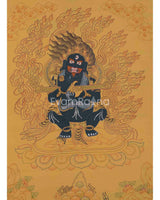

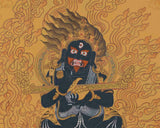
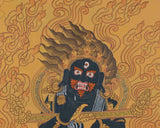
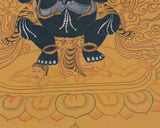
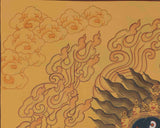
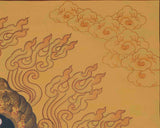
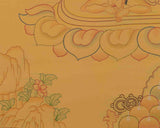
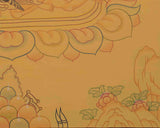
Original Hand-Painted Sakya Mahakala | Tibetan Buddhist Wrathful Dharmapala

100% AUTHENTIC

HANDPAINTED

FREE SHIPPING
Original Hand-Painted Sakya Mahakala
About Out thangka
Sakya Mahakala is a revered figure in Tibetan Buddhism, depicted with a wrathful appearance, symbolizing his determination to protect the Dharma and its practitioners. He is depicted in a seated posture, atop a lotus throne, and on a corpse, symbolizing his triumph over death and the impermanent nature of existence. His two-handed holds a vajra (thunderbolt) and a kapala (skull cup), symbolizing the transformation of negative emotions into wisdom and the realization of emptiness.
Sakya Mahakala is adorned with various symbolic ornaments, such as a crown with five skulls representing the five poisons or painful emotions he has overcome, a necklace of 50 freshly severed heads symbolizing the 50 negative emotions or mental afflictions, snakes symbolizing his mastery over death and transformation, and a third eye symbolizing his ability to perceive the truth beyond ordinary perception.
Sakya Mahakala is surrounded by flames, accompanied by attendants, guardians, or other deities, or seated under a man representing an important lineage holder or patriarch within the Sakya tradition. Devotees invoke his blessings and seek his protection through prayers, rituals, and meditation practices under the Sakya Mahakala Thangka.
------------------------------------------------------------------
Size: 17"/ 43cm (width) x 24"/ 61 cm (height)
Materials: Cotton Canvas, Acrylic Colors, Genuine 24K Gold
------------------------------------------------------------------
THIS THANGKA IS HAND-PAINTED IN THE TRADITIONAL STYLE AND THE QUALITY IS HIGH
------------------------------------------------------------------
How to take care of your thangka?
-Regular Inspection of your thangka; examine the borders and all attachments.
-Keep thangkas covered when they are on display but not in use.
-Rotate thangkas between display and storage regularly, two to four times a year, to reduce the amount of exposure to light. Keep away from sunlight and humidity.
-Do not apply liquids or other materials to the surface of the thangka.
How to Take Care of Your Thangka?
- Hang your thangka in a traditional silk brocade.
- Regularly inspect your thangka; examine the borders and all attachments.
- Keep thangkas covered when they are on display but not in use.
- Rotate thangkas between display and storage two to four times a year to reduce exposure to light. Keep them away from sunlight and humidity.
- Do not apply liquids or other materials to the surface of the thangka.



















